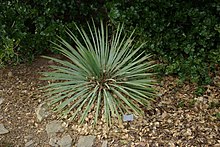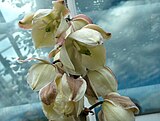
Sanguinaria canadensis, bloodroot, is a perennial, herbaceous flowering plant native to eastern North America. It is the only species in the genus Sanguinaria, included in the poppy family Papaveraceae, and is most closely related to Eomecon of eastern Asia.

Yucca filamentosa, Adam's needle and thread, is a species of flowering plant in the family Asparagaceae native to the southeastern United States. Growing to 3 metres tall, it is an evergreen shrub valued in horticulture.

Plains coreopsis, garden tickseed, golden tickseed, or calliopsis, Coreopsis tinctoria, is an annual forb. The plant is common in Canada, northeast Mexico, and much of the United States, especially the Great Plains and Southern states where it is often called "calliopsis". The species is also widely cultivated and naturalized in China.

Eriogonum fasciculatum is a species of wild buckwheat known by the common names California buckwheat and flat-topped buckwheat. Characterized by small, white and pink flower clusters that give off a cottony effect, this species grows variably from a patchy mat to a wide shrub, with the flowers turning a rusty color after blooming. This plant is of great benefit across its various habitats, providing an important food resource for a diversity of insect and mammal species. It also provides numerous ecosystem services for humans, including erosion control, post-fire mitigation, increases in crop yields when planted in hedgerows, and high habitat restoration value.

Ratibida columnifera, commonly known as upright prairie coneflower, Mexican hat, and longhead prairie coneflower, is a perennial species of flowering plant in the genus Ratibida in the family Asteraceae. It is native to much of North America and inhabits prairies, plains, roadsides, and disturbed areas from southern Canada through most of the United States to northern Mexico.

Lithospermum incisum is a species of flowering plant in the borage family known by several common names, including fringed puccoon, narrowleaf stoneseed, fringed gromwell, narrowleaf puccoon, and plains stoneseed. It is native to much of central Canada and the United States, where it is known from many types of habitat, but particularly piñon-juniper woodland. It is a hairy perennial herb growing from a narrow brown to black taproot and woody caudex. It produces a cluster of stems up to about 30 centimeters long. The stems are lined with narrow, pointed leaves up to 6 centimeters long. The slender, trumpet-shaped flowers are pale to bright yellow or gold, and may approach 4 centimeters long. The corolla face is 1 to 2 centimeters wide, its lobes sometimes ruffled. The smaller cleistogamous (closed) flowers are the main producers of seed.

Krascheninnikovia lanata is a species of flowering plant in the family Amaranthaceae, known by the common name winterfat. It is native to much of western North America: from central Western Canada; through the Western United States; to northern Mexico.
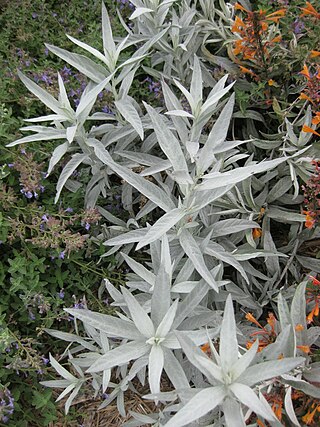
Artemisia ludoviciana is a North American species of flowering plant in the daisy family Asteraceae, known by several common names, including silver wormwood, western mugwort, Louisiana wormwood, white sagebrush, lobed cud-weed, prairie sage, and gray sagewort.
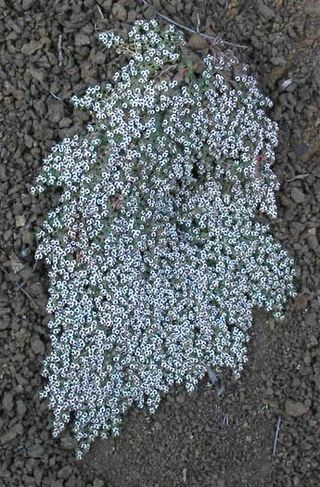
Euphorbia polycarpa is a species of spurge known by the common name smallseed sandmat. It is native to the southwestern United States and northern Mexico, especially the deserts and other dry, sandy areas. This is a perennial herb producing stems that trail along the ground to form a clump or mat, sometimes growing somewhat upright. The leaves are each under a centimeter long. They are round or oval-shaped and have triangular stipules at the bases. What looks like a single flower is actually an inflorescence of many staminate (male) flowers united around a single central pistillate (female) flower. Bracts surrounding the flower unit are white and petal-like. The fruit is a thin spherical capsule less than 2 millimeters wide layered over a seed.

Balsamorhiza sagittata is a North American species of flowering plant in the tribe Heliantheae of the family Asteraceae known by the common name Arrowleaf Balsamroot. Also sometimes called Oregon sunflower, it is widespread across western Canada and much of the western United States.
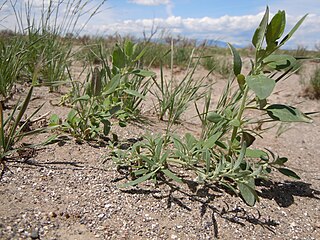
Chenopodium leptophyllum is a species of flowering plant in the family Amaranthaceae known by the common name narrowleaf goosefoot.

Dieteria canascens is an annual plant or short lived perennial plant in the family Asteraceae, known by the common names hoary tansyaster and hoary-aster.

Ribes cereum is a species of currant known by the common names wax currant and squaw currant; the pedicellare variety is known as whisky currant. The species is native to western North America.
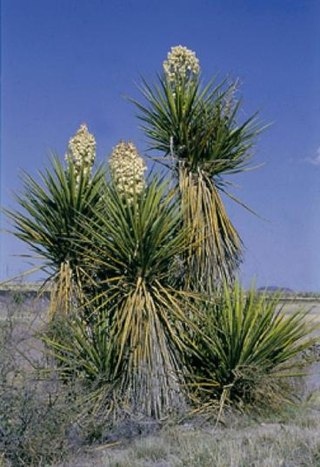
Yucca faxoniana is a bladed evergreen shrub of the genus Yucca. It is known by the common names Faxon yucca,Spanish dagger, and giant dagger.

Stanleya pinnata is a species of flowering plant in the family Brassicaceae known as desert prince's-plume. It is a perennial herb or shrub native to North America.

Zinnia grandiflora is a species of flowering plant in the family Asteraceae known by the common names Rocky Mountain zinnia and plains zinnia. It is native to the southwestern and south-central United States and northern Mexico. Zinnia Grandiflora is used by many Native American tribes for its medicinal properties as well as for its vibrant yellow color for paint and dyes. there have also been experiments done using Zinnia Grandiflora to understand the extent of its healing abilities.
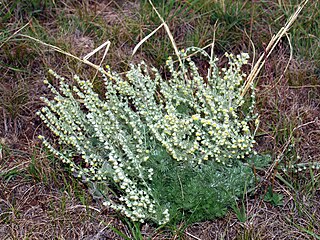
Artemisia frigida is a widespread species of flowering plant in the aster family, which is known as the sunflower family. It is native to Europe, Asia, and much of North America. In parts of the north-central and northeastern United States it is an introduced species.

Lycium pallidum is a species of flowering plant in the nightshade family known by the common names pale wolfberry and pale desert-thorn. It is native to northern Mexico and the southwestern United States. In Mexico it can be found in Sonora, Chihuahua, Zacatecas, and San Luis Potosi. In the United States it occurs from California to Texas and as far north as Utah and Colorado.

Hedysarum boreale is a species of flowering plant in the Fabaceae, or legume family, and is known by the common names Utah sweetvetch, boreal sweet-vetch, northern sweetvetch, and plains sweet-broom. It is native to North America, where it is widespread in northern and western regions of Canada and the United States. The ssp. mackenzii can even be found in the Canadian Arctic Archipelago.
This is a list of plants and how they are used in Zuni culture.
